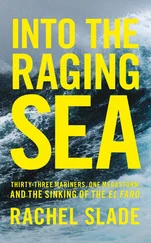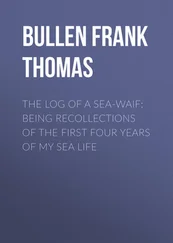Shultz spent the next several minutes logging alternative routes and waypoints into the ship’s GPS system. He wasn’t completely sure he trusted Joaquin, and he wanted to give the other officers various options if they ran into trouble. The storm had proven an unpredictable and erratic foe; Shultz wanted to work out as many escape routes as he could.
Logging in all those new waypoints (which made a high-pitched beep with each entry), irritated Davidson.
“It’s a good little diversion,” he scoffed at Shultz. “Are you feelin’ comfortable with that, Chief Mate?”
“Better. Yes, sir.”
“You can’t run every single weather pattern,” Davidson barked. His chief mate was already rubbing him the wrong way, and they’d only been up for an hour.
Shultz didn’t want to piss off Davidson. He was brand-new to the ship, new to the captain, and relatively new to the Atlantic. He’d come from shipping for years in the Pacific Northwest and was happy to be on the Puerto Rican run, at least temporarily, closer to Florida where his petite native Brazilian wife and two teens lived. He was a dedicated husband who vigorously embraced his wife’s Catholicism.
Nothing was more sacred aboard a ship than respecting the chain of command. Though he had as much experience as Davidson, Shultz knew to defer to his captain in all things to ingratiate himself to his superior. If he thought that sixty miles from the eye of a major storm didn’t sound right, he kept it to himself. A challenge like that could be viewed as insubordination. Shultz had kids approaching college age. Like everyone else, he had expenses. He needed this job.
Outside in the wild Atlantic, however, there were ominous signs.
At 6:40 a.m., Davidson watched the rising sun set the eastern horizon aflame, reminding him of an old adage. “Look at that red sky over there,” he said to Shultz. “Red in the morning, sailors take warning. That is bright.”
For thousands of years, sailors have viewed crimson skies at dawn as a bad omen. Science backs this up: Red has the longest wavelength in the color spectrum—powerful enough to penetrate the dust and moisture kicked up by an atmospheric event, such as a major storm. Other colors in the rainbow get scattered by thick storm clouds, leaving the sky a blazing scarlet.
Dawn on September 30, 2015, was distorted by a terrific atmospheric event brewing dead ahead of El Faro .
Chapter 4
Third Mate Jeremie Riehm
28.42°N -78.47°W
Third Mate Jeremie Riehm arrived on the bridge shortly before his 8:00 a.m. shift and watched the tropical sun rise into an unctuous sky. Another steamy Caribbean day ahead. The air-conditioning had been cranking all night and now it was chilly on the bridge in spite of the stickiness of the morning outside.
The scorching sun would soon beat down on the metal roof of the wheelhouse, so Jeremie wore a T-shirt and shorts under a light jacket. His thick brown hair flopped into his eyes. He’d brusquely brush it up and back with his fingers giving it a permanent flip. Forty-six years old, he looked like a rugged, slightly stockier Brad Pitt.
“You hear about the storm?” Chief Mate Shultz asked Jeremie.
“Yes, I’m aware of it,” he answered. “Caught a little bit of it on the news. I heard it’s gonna be a hurricane tomorrow or later today according to the Weather Channel.”
Shultz took Jeremie over to the chart table to show the new course he and the captain—who was downstairs getting breakfast—had prepared earlier that day. The chief mate pointed to Joaquin’s projected course, drawn in wax pencil on a clear plexiglass panel laid over the paper nautical chart. Tiny numbers scattered across the white sea indicated depths in fathoms; there was twelve thousand feet of ocean below them. The shallow Bahama banks blocking their escape route to the west appeared as a scorpion-shaped expanse of light blue. Sinuous purple lines represented the elaborate network of underwater communication cables that link the United States to the Caribbean islands, South America, and Europe—cords that could be cut by the keel of a ship if it dragged over them.
Joaquin had moved farther west and south, which meant that if they’d continued on their original course, they’d run straight into it, Shultz said. “I mean, our timing was perfect to reach the eye. Now worse comes to worse, we can duck in behind the islands.”
“We’re gonna get slammed tonight, though,” Jeremie said grimly, studying the chart in front of him. A slight heading change wouldn’t buy them much, he thought, and sixty miles from the eye was at least forty miles too close.
Jeremie looked up to nod at Jack Jackson, his helmsman on the 8:00 to noon watch, who’d just come up from breakfast. Jack stood by while the chief mate and third mate discussed the new plan. “It’s been too quiet this season,” Jack observed.
“Been that way last year and the year before,” agreed Jeremie. Very quiet hurricane seasons. Good weather could breed complacency.
“Out in the Pacific, it’s been one typhoon after the other, a daisy chain of ’em,” Jack said. “One in Taiwan hit 180 miles per hour.” He shook his head thinking about that kind of wind. It was enough to give an old mariner like himself a good scare.
Davidson came back up to the bridge to check in on his third mate. “So we got a little weather coming in,” he told him. “I’m sure you heard,” he continued. “Joaquin morphed its ugly head between the time we left and the morning when we woke up. Tough to plan when you don’t know but we made a little diversion here. We’re gonna be further south of the eye. We’ll be about sixty miles south of the eye. It should be fine. We are gonna be fine—not should be—we are gonna be fine.”
The captain looked at his third mate intently, confirming that the officer understood the plan. Satisfied, he left the bridge to Jeremie and Jack who together watched the rising sun cook the already hot Caribbean waters into a soupy haze.
Jeremie was known for speaking his mind. Unlike the other officers aboard El Faro , he’d come up through the hawsepipe, meaning he hadn’t graduated from one of the country’s seven maritime academies. Instead, he’d signed on to the merchant marine as general crew when he was eighteen years old and worked his way up. During his downtime aboard the vessel, he’d studied the ship’s books and manuals and often surprised his fellow officers with the depth of his knowledge. Most of them were older and had little interest in exploring all the bells and whistles offered by advancing technology. They could run a ship with or without it. But Jeremie liked figuring things out.
Once he had enough proficiency and experience, Jeremie screwed up his courage and took the third mate’s test. The exam is a brutal, three-day trial of knowledge and nerves. It was especially hard for Jeremie, who got anxious at the thought of taking tests. After passing, he didn’t want to go through that again, so he remained working as a third mate for the next decade. Sailing as a second mate would have meant more money and more authority on the bridge, but for him, it wasn’t worth the stress. He lived modestly on shore, focused on family. He was married to an African American woman who ran a day-care center on the remote Florida island where they lived with their two teenage children. When he was off duty, he helped her with the business and kept to himself.
A few years back, Jeremie joined his fellow ship’s officers Captain Pete Villacampa, Chief Mate Paul Haley, and Second Mate Charlie Baird at their union’s ultra-advanced simulation center in Miami. He was a generation younger than the other officers. For four days, they worked together on a computer-generated bridge, which rocked and rolled like a real ship, enough to make a person seasick, as the program generated complex maritime situations for them to work their way out of. Jeremie’s understanding of the weather systems, radar, and loading software—things he’d taught himself—proved invaluable. The team earned one of the highest scores the instructor had ever recorded.
Читать дальше












